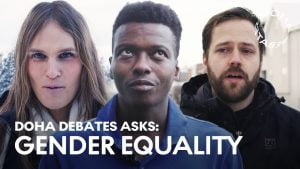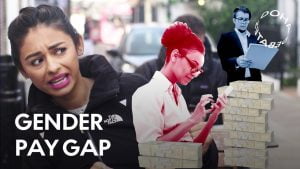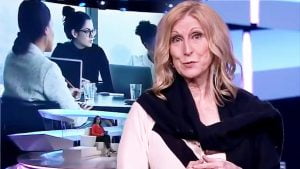
Gender Equality
Recent research suggests that most of us — including Generation Z — won’t live to see gender equality achieved worldwide, a milestone that is almost 100 years away. Awareness of this fact has fueled conversations around how to address this, and in this debate, our experts discuss one possible solution: quotas.
Unit 1: Doha Debates Asks

Doha Debates Asks: Are There Gender Differences?
Essential questions
- What is the first word that comes to mind when you hear “gender equality”?
- Have you been discriminated against because of your gender?
- What are the consequences of gender inequality?
- What are some obstacles to gender equality?
- How can governments address gender inequality?
- Are there fundamental differences among genders?
- Is the world making progress toward gender equality?
Lesson 2: The Gender Pay Gap

Is The Gender Pay Gap Getting Worse?
Essential questions
- What places in the world is the gender pay gap is getting worse?
- Which countries have the largest pay gap?
- How far away are we from gender equality in pay?
- What are benefits of gender equality?
- Why are we so far away from gender equality?
- What role do political systems play in gender equality?
- How do biases limit a person over a lifetime?
- What are stereotypes about “strong women”?
Unit 3a: Randa Abdel-Fattah

Randa Abdel-Fattah: Gender Quotas Disrupt Gender & Racial Hierarchies
Essential questions
What are ways to disrupt gender and racial hierarchies?
What are benefits and drawbacks to affirmative action?
Why are positions of power primarily held by men?
How might quotas take into account both sexism and racism?
In what ways do white women enjoy racial privilege?
How will quotas redistribute the power dynamic?
What ways will women be able to transform and revitalize knowledge production?
Unit 3b: Ayishat Akanbi

Ayishat Akanbi: Gender Equality Must Go In Both Directions
Essential questions
What contributes to gender inequality?
How might quotas create strife in the workplace where they are used?
Why is it important that equality go in both directions?
What jobs are traditionally considered “women’s jobs”?
How do people feel tokenized through the use of quotas?
What are examples of preloaded ideas that people are thought to have?
How might people be seen for who they are, not what they are?
Unit 3c: Christina Hoff Sommers

Christina Hoff Sommers: Quotas Are Not The Answer to Gender Equality
Essential questions
How might quotas send the wrong message?
What is the evidence that quotas do or do not work?
In what ways are quotas harmful in different parts of the world?
What are possible solutions to gender inequality?
How would gender equality benefit from free expression?
Which barriers need to be removed to create greater gender equality?
Why is it important to have gender equality?
Unit 4: Connector

How to get along with other people
Essential questions
What is a Majlis?
Why are some women more marginalized than others?
What is feminism?
What is identity politics?
Which is a larger issue, race or class?
What role might quotas play in gender equality?
What role must men play in creating greater gender equality?
In what ways does diversity play in gender equality?
About Deep Dive
Doha Debates hosts discussions on the world’s most pressing challenges to bridge differences, build consensus and identify solutions. In each moderated live debate, experts share their experiences and propose concrete plans. Doha Debates also offers digital resources such as videos and articles to help students build a deep understanding of the issues and to foster ongoing conversations.
Stay up to date and learn about new resources for educators and students.
Please sign up to receive immediate access to curriculum for this module.
Gender Equality
About Deep Dive
Doha Debates hosts discussions on the world’s most pressing challenges to bridge differences, build consensus and identify solutions. In each moderated live debate, experts share their experiences and propose concrete plans. Doha Debates also offers digital resources such as videos and articles to help students build a deep understanding of the issues and to foster ongoing conversations.
Guide to using Doha Debates’ curriculum
Doha Debates’ curriculum may be used in a variety of ways. Each section has an associated individual lesson plan.
It is possible to use one lesson plan of your choice that best fits your timeframe. However, this complete and comprehensive curriculum packet is designed to build on the previous sections and lessons.
The curriculum will focus on engaging students through the following techniques:
- Active learning
- Collaborative learning
- Discussions
- Increasing student motivation and participation
- Problem-based learning
- Use of effective questions
- Writing assignments
All of the lesson plans have at least one form of student engagement related to the lesson. Content can be tailored to most subjects.
Specific time allotments are outlined on the next page and will be found in each lesson plan within the learning plan section. You may use any part of the learning plan components.
Gender Equality
Complete Curriculum for Gender Equality
Doha Debates hosts discussions on the world’s most pressing challenges to bridge differences, build consensus and identify solutions. In each moderated live debate, experts share their experiences and propose concrete plans. Doha Debates also offers digital resources such as videos and articles to help students build a deep understanding of the issues and to foster ongoing conversations.
Unit 1: Doha Debates Asks
Flexible instruction
This lesson and related activities are designed to support in-class learning, e-learning and distance learning (students working online at home while the instructor checks in digitally).
Stage 1: Desired goals
Established goal
Know where people stand on a variety of questions regarding the issue of gender equality.
Meaning
Understandings
Students will understand that…
There are myriad obstacles to gender equality in many parts of the world.
Women face greater discrimination on average than men.
Women face greater difficulty in acquiring the same resources as men.
Governments should do a better job of creating laws that protect all people.
Discrimination is not a new part of society and culture.
Essential questions
What is the first word that comes to mind when you hear “gender equality”?
Have you been discriminated against because of your gender?
What are the consequences of gender inequality?
What are some obstacles to gender equality?
How can governments address gender inequality?
Are there fundamental differences among genders?
Is the world making progress toward gender equality?
Acquisition
Students will know…
Different issues associated with gender equality.
Opinions people have about different aspects of gender equality.
Students will be able to…
Recognize the personal views people have about gender equality.
Express how other people see the issues associated with gender equality.
Engagement
Students will…
Understand what other people think about gender equality through direct discussion.
Stage 2: Evidence & assessment
Assessment evidence / Performance tasks
Oral or written response to the essential questions.
Explanation of how students arrive at their view regarding gender equality.
Stage 3: Learning plan
In-class, e-learning and distance learning
Note: The pacing outlined below is for in-class learning and may need to be adjusted for e-learning or distance learning.
5-10 minutes
Discuss what comes to mind when you hear the question, “What is gender equality?”
10-15 minutes
Discuss the essential questions in small groups.
10-15 minutes
Discuss the essential questions as a class/virtual learning group.
5 minutes
Watch the video Gender Equality: Doha Debates Asks.
10-15 minutes
Focus on the question, “How does gender equality play out in different parts of the world?” Talk about what you have heard or seen in different parts of the world through media or even personal experience. How real is this issue, and does it matter where you live in the world, and why?
Activities (choose one or more)
One day
Ask three to five people outside of your class/learning group four of the essential questions. The data may be collected in person or virtually. Write each person’s responses to share as a class/group.
One day+
Talking with someone about a personal experience with gender equality or inequality is the best way to have a deeper understanding of the topic.
Speak with three people about an experience that best represents the issue. Try to talk with a wide variety of age groups. Also, try to talk with at least one person who has spent the majority of life in another country. This is a great activity to use through social media and virtual talks.
15-20 minutes
Share the responses from the first outside classroom activity once the information has been collected.
15-20 minutes
Discuss the findings from the people you spoke with about gender equality and inequality.
Unit 2
Flexible instructions
This lesson and related activities are designed to support in-class learning, e-learning and distance learning (students working online at home while the instructor checks in digitally).
Stage 1: Desired goals
Established goal
Students will have a deeper understanding of gender inequality in pay and key issues based on Doha Debates: Is The Gender Pay Gap Getting Worse?
Meaning
Understandings
Students will understand that…
Inequality may start before the person is even born.
There is a wide range of pay gaps between men and women around the world.
Overall life satisfaction tends to increase as the gender inequality gap narrows.
Women perform greater amounts of unpaid work than men.
Governments can play a role in reducing gender inequality.
Essential questions
Where are places in the world where the gender pay gap is getting worse?
Which countries have the largest pay gap?
How far away are we from the gender equality in pay?
What are benefits of gender equality?
Why are we so far away from gender equality?
What role do political systems play in gender equality?
How do biases limit a person over a lifetime?
What are stereotypes about “strong women”?
Acquisition
Students will know…
Key connections between gender equality and pay.
Methods that might mitigate the gender pay gap.
Students will be able to…
Recognize the reasons why gender inequality stills exists.
Express problems related to making changes to gender inequality.
Engagement
Students will…
Understand other people’s general views about gender equality and pay.
Acknowledge the different situations women deal with on a daily basis.
Stage 2: Evidence & assessment
Assessment evidence / Performance tasks
Oral or written response to the essential questions.
Explanation of how each students arrives at their view.
Data collection from other people outside of the classroom regarding gender equality and pay.
Stage 3: Learning plan
In-class, e-learning and distance learning
Note: The pacing outlined below is for in-class learning and may need to be adjusted for e-learning or distance learning.
10 minutes
Watch the Doha Debates video: Is The Gender Pay Gap Getting Worse?
10-15 minutes
Discuss the essential questions in small groups/virtual learning groups and then as a class or discuss the questions as a class only.
15-20 minutes
Visit the World Economic Forum’s Mind the 100 Year Gap. Look through the facts provided and think about how it affects people around the world on a daily basis.
Activities (choose one or more)
One day
How have things changed over time when it comes to gender and pay? The best way to find out is to ask the people who experience it. Develop two or three questions about gender and pay. Find five women of different ages and backgrounds to ask the questions. Talk with the oldest person you can find, a woman just entering the workforce, and, if possible, one person who is the head of a company or has started her own business. This is a great activity to do virtually and to talk about with your family and friends.
Ask three to five people outside of the classroom the essential questions from this lesson. This may be done either in person or over Zoom, Skype or other ways to connect digitally. Try to make connections with other people outside of your own town, state or even country. The data will be gathered, analyzed and then synthesized into a comprehensive summary of the data results. The results will be presented to the class.
These two activities may be completed during the next class meeting.
10-15 minutes
Discuss the results collected from asking the essential questions.
10-15 minutes
Discuss what each person thought about the data viewed on the World Economic Forum website.
Unit 3 - The Gender Pay Gap
Flexible instructions
This lesson and related activities are designed to support in-class learning, e-learning and distance learning (students working online at home while the instructor checks in digitally).
Stage 1: Desired goals
Established goal
Establish a foundation of the primary reasons gender inequality continues to be an issue specifically in the area of pay.
Meaning
Understandings
Students will understand that…
There are ways to understand and change a person’s biases.
The pay gap is not as simple as it is often made out to be.
There are alternatives to the current problems that create the gender pay gap.
Even women at the highest levels of their professions continue to deal with pay inequity.
Essential questions
Is there a gender pay gap?
What are alternatives to the gender pay gap?
How does the unconscious mind play into gender bias?
Where do our biases originate?
How much control does a person have over personal biases?
Acquisition
Students will know…
Key facts about gender bias.
Different ways people deal with gender bias on a conscious and unconscious level.
Students will be able to…
Recognize the various ways gender bias presents itself.
Express ways to help deal with gender bias.
Engagement
Students will…
Better understand possible unconscious biases the student may have.
Stage 2: Evidence & assessment
Assessment evidence / Performance tasks
Students will watch short videos and discuss additional problems presented in each.
Students will form groups to find additional evidence for each of videos shown.
The additional evidence found will be presented to the class/learning group either in oral form or through a brief visual presentation.
Completion of associated tasks with each video.
Oral or written response to the essential questions.
Explanation of how each student arrives at their view.
Stage 3: Learning plan
In-class, e-learning and distance learning
Note: The pacing outlined below is for in-class learning and may need to be adjusted for e-learning or distance learning
15-30 minutes
Start with essential questions. The questions may be discussed in a small group first and then as a whole class/learning group.
10 minutes
Watch Are the U.S. women’s soccer team players paid less? The gender pay gap explained and discuss as a class. Essential question: Why is the women’s soccer team making more revenue than the men’s team but getting paid less?
Activities (choose one or more)
One day
We all like to think we are not biased. It may be easy to act as if we do not have any biases but the unconscious mind may be different. The nonprofit organization Project Implicit has developed tests to see if and what you might have biases for or against.
You will see several options on the home page. The first one to click on is Project Implicit: Social Attitudes. Try taking the Gender-Career test as well as the Gender-Science test. Certainly try other tests, and encourage your family and friends to take them.
The next activity may be completed during the next class meeting.
10-15 minutes
As a class, discuss the results of the implicit bias tests.
Unit 4a - Speaker Randa Abdel-Fattah
Flexible instructions
This lesson and related activities are designed to support in-class learning, e-learning and distance learning (students working online at home while the instructor checks in digitally).
Stage 1: Desired goals
Established goal
Demonstrate an understanding of how quotas are necessary to create both gender and racial equality.
Meaning
Understandings
Students will understand that…
Women of color face both sexism and racism.
Men have unequal access to social, economic and political power.
White women have racial privilege.
Quotas should not give women unfair advantage.
Women hold few positions in the academic world.
Essential questions
What are ways to disrupt gender and racial hierarchies?
What are benefits and drawbacks to affirmative action?
Why are positions of power primarily held by men?
How might quotas take into account both sexism and racism?
In what ways do white women enjoy racial privilege?
How will quotas redistribute the power dynamic?
What ways will women be able to transform and revitalize knowledge production?
Acquisition
Students will know…
Key issues surrounding the need for quotas in areas such as academics.
Differing ways to deal with sexism and racism.
Students will be able to…
Explain how it is possible to use quotas in a positive way for both men and women.
Describe ways women are not a monolithic group.
Engagement
Students will…
Learn about how people react between the sexes in an online game.
Stage 2: Evidence & assessment
Assessment evidence / Performance tasks
Discuss the speaker’s general position on gender equality based on the video and background content and develop possible solutions to issues the students may have with the speaker.
Group presentation of data found to answer each of the essential questions presented by the speaker.
Stage 3: Learning plan
In-class, e-learning and distance learning
Note: The pacing outlined below is for in-class learning and may need to be adjusted for e-learning or distance learning
10-15 minutes
Watch Randa Abdel-Fattah Doha Debates presentation. Write key points of the speaker’s videos.
20-40 minutes
Read the background content to develop a deeper understanding of speaker.
5-10 Minutes
In small groups discuss what each person drew from the videos and background information as key areas.
10-20 Minutes
Discuss each group’s findings as a class/learning group.
15-30 Minutes
Groups will pick three essential questions from the speaker and find additional data to better understand the question.
Activities (Choose one or more)
60 Minutes
How you speak with other people depends on the situation. Champlain College has created a game called “Breakaway”, which mixes digital soccer drills with interstitials that ask players how to speak to their female companions.
Play the game to see how you handle different situations on the field. Encourage your family and friends to try the game as well. Post your results on social media and tag @DohaDebates and @ProjectExplorer.
1 – 2 days+
Students will form small groups. Each student in the group will ask five people (non-students outside of the school setting) the essential questions from this lesson. This may be done either in person or over Zoom, Skype or other ways to connect digitally. Try to make connections with other people outside of your own town, state or even country. The data will be gathered, analyzed and then synthesized into a comprehensive summary of the data results. The results will be presented to the class.
Background info: Randa Abdel-Fattah
About Randa Abdel-Fattah
Randa Abdel-Fattah is an internationally published award-winning author. Her novels include Does My Head Look Big in This?, Ten Things I Hate About Me, Where The Streets Had A Name and Noah’s Law. Her children’s novels are Buzz Off, The Friendship Matchmaker and The Friendship Matchmaker Goes Undercover, and her first adult novel is No Sex in the City. A passionate human rights activist, Randa is frequently sought for comment by the media, and has appeared on television programs such as the ABC’s Q & A, the ABC’s First Tuesday Book Club, SBS’s Insight and Channel Seven’s Sunrise. Randa is a regular speaker at schools and writers’ festivals in Australia and overseas. She uses her writing, talks and workshops to address issues of identity, race politics, prejudice, religion, human rights and bullying.
Randa’s key points from her Doha Debates’ presentation
In Australia, almost 95% of Parliament and senior executives are of Anglo-European background.
There is a need to disrupt gender and racial hierarchies.
Historically inbuilt mechanisms means that men dominate boardrooms and academia — this give them access to social, economic and political power.
Of the nearly 19,000 professors in the UK, 4,000 are women and only 25 are Black women.
Gender inequality impacts women, but some more than others.
Women of color face sexism and racism.
Gender equality often sees women as a single axis of oppression.
White women enjoy racial privilege.
Podcast appearances
Better Words, “When ideologies clash”
I Don’t Know How She Does It, “Mother of four Randa Abdel-Fattah sometimes cries at night”
The Booktopia Books Podcast, “Randa Abdel-Fattah on When Michael Met Mina“
Separate Stories, “Randa Abdel-Fattah on diversity in Australian literature”
Videos
Islamophobia as “Everyday Doing,” ISRA Academy
Faith, fashion, fusion: Muslim women’s style in Australia, Powerhouse Museum, Sydney
Government conferring “permission to hate” Muslims, ABC News (Australia)
PRC Live in Conversation with Randa Abdel-Fattah, NSW Department of Education – Learning Systems
Weddings, Gaza and Losing Faith, ABC Q+A
Articles
The National News, “Anthology holds up a magnifying glass to reveal the struggles of Arab-Australians,” by Olivia Snaje.
ABC News, “Randa Abdel-Fattah spins Islamophobia into Aussie teen romance,” by Jennifer Wong
Book Riot, “Once Upon an Eid anthology: It’s the most joyous time of the year,” by Shireen Hakim
Mint, “A story for young adults in the post 9/11 world,” by Jaya Bhattacharji Rose
The National News, “Islamophobia on the rise in Australia,” by Giovanni Torre
Other
Unit 4b - Speaker Ayishat Akanbi
Flexible instructions
This lesson and related activities are designed to support in-class learning, e-learning and distance learning (students working online at home while the instructor checks in digitally).
Stage 1: Desired goals
Established goal
Demonstrate an understanding of the importance that quotas have benefits but we need to revise cultural expectations.
Meaning
Understandings
Students will understand that…
Gender equality calls for a holistic approach.
Quotas may create strife in the work place.
Gender equality needs to go in both ways.
There is an assumption that people come with preloaded ideas and beliefs.
Individuals need to be seen as individuals not just a representative of their group.
Essential questions
What contributes to gender inequality?
How might quotas create strife in the work place where they used?
Why is it important that equality go in both directions?
What jobs are traditionally considered “women’s jobs”?
How do people feel tokenized through the use of quotas?
What are examples of preloaded ideas that people are thought to have?
How might people be seen for who they are not what they are?
Acquisition
Students will know…
Key ways gender equality creates positive and negative consequences.
Differing ways people view gender equality.
Students will be able to…
Explain possible ways gender equality may benefit everyone.
Recognize the importance of people making incorrect assumptions about others.
Engagement
Students will…
Learn about issues faced by different genders in conflict and migration.
Stage 2: Evidence & assessment
Assessment evidence / Performance tasks
Discuss the speaker’s general position on gender equality based on the video and background content, and develop possible solutions to issues the students may have with the speaker.
Group presentation of data found to answer each of the essential questions presented by the speaker.
Stage 3: Learning plan
In-class, e-learning and distance learning
Note: The pacing outlined below is for in-class learning and may need to be adjusted for e-learning or distance learning.
15-20 minutes
Watch the speaker’s Doha Debates presentation. Write key points of the speaker’s presentation for the Doha Debates segment.
20-40 minutes
Read the background content to develop a deeper understanding of speaker.
5-10 minutes
In small groups discuss what each person drew from the videos and background information as key areas.
10-20 minutes
Discuss each group’s findings as a class/learning group.
15-30 minutes
Data helps students understand the larger context of an issue like gender equality. Our World In Data will allow students to visually see how gender equality impacts people around the world. Students will look at the graphs presented and discuss what the data says about gender equality.
Outside learnings
One day
What role might gender play in how a person experiences conflict and migration? The BBC created Syrian Journey: Choose your own escape route, a simulation to better understand what is happening in Syria. The game allows you to start as man or woman. Have students play the game both ways to see how the outcomes might change. Encourage friends and family to play the game and discuss the results. Post your results on social media and tag @DohaDebates and @ProjectExplorer.
1 – 2 days+
Students will form small groups. Each student in the group will ask five people (non-students outside of the school setting) the essential questions from this lesson. This may be done either in person or over Zoom, Skype or other ways to connect digitally. Try to make connections with other people outside of your own town, state or even country. The data will be gathered, analyzed and then synthesized into a comprehensive summary of the data results. The results will be presented to the class.
Background info: Ayishat Akanbi
About Ayishat Akanbi
Ayishat Akanbi is a fashion stylist, writer and cultural critic based in London. Making an impact on the fashion scene in 2010, Ayishat’s signature style has amassed a growing following. She has successfully found a balance between maintaining cultural awareness, individuality and an archetypal footprint in both creative and academic spaces alike. Aside from styling, Ayishat is a rising voice, and her thought-provoking essays has expanded her horizons to museums, universities and political festivals. Her keen interest in socio-political issues, music and culture has struck a cord within the arts, and her cultural critique has been called upon by the Tate Modern, the Design Museum, the Barbican and the V&A. Her photography is also exemplary of her cultural observations. Ayishat’s technique is rooted in her ability to establish a political, mental and artistic understanding of style, which she believes is accessible to any- and everyone. Among other accolades, Ayishat has been featured in GQ, Dazed, Notion and The Metro, and is the lead on screen stylist on E4’s 2018 show My Hotter Half as well as contributing to a number of shows news segments on BBC, Channel 4, CNN and CBBC.
Ayishat’s key points from her Doha Debates’ presentation
If we don’t like gender quotas, then we have to build a world where they are not needed.
The situation calls for a holistic approach not only a political reaction.
Recognize what contributes to gender equality.
Betrayal of women to say there is only one issue that creates gender inequality.
Quotas are a no-brainer.
Equality must go in both directions.
Equality must be implemented not just at the top, but across the board.
There is an assumption that people come preloaded with ideas.
The difference between individuals is much larger than the group.
Individuals should be seen as individuals not just a representative of their group.
Liberation and equality is the chance for people to not be seen for what they are but who they are.
Podcast appearances
Every Day Hustle, “Everyone has something that makes them different”
Don’t @ Me with Ayebatonye, “Discussing the problem with wokeness with Ayishat Akanbi”
What if a Black Girl Knew? “Racism, coming out, feminism, with Ayishat Akanbi”
Reality Riffing with Guru Jagat, “The culture conversation”
Videos
“The problem with wokeness,” SOH Talks & Ideas Archives
“The problem with cancel culture,” Double Down News
“The future of feminism,” SOH Talks & Ideas Archives
“Is there a hierarchy to free speech?” Subjectivity UK
Other
Unit 4c - Speaker Christina Hoff Sommers
Flexible instructions
This lesson and related activities are designed to support in-class learning, e-learning and distance learning (students working online at home while the instructor checks in digitally).
Stage 1: Desired goals
Established goal
Articulate the understanding that quotas do not advance gender equality and are based on faulty assumptions.
Meaning
Understandings
Students will understand that…
Women often bare the stigma of preferential treatment because of quotas.
Quotas do not show that they boost corporate profits over time.
Quotas may be harmful in less prosperous, non-democratic countries.
A key to gender equality is free expression and discourse.
The importance of removing barriers.
Under conditions of opportunity, men and women flourish.
Essential questions
How might quotas send the wrong message?
What is the evidence that quotas do or do not work?
In what ways are quotas harmful in different parts of the world?
What are possible solutions to gender inequality?
How would gender equality benefit from free expression?
Which barriers need to be removed to create greater gender equality?
Why is it important to have gender equality?
Acquisition
Students will know…
Key reasons quotas do not always work in the intended manner.
Differing ways women may actually suffer because of quotas.
Students will be able to…
Express the importance of creating gender equality beyond quotas.
Recognize the need to develop greater discourse about gender equality.
Engagement
Students will…
Understand where other people stand on the issue of gender quotas.
Stage 2: Evidence & assessment
Assessment evidence / Performance tasks
Discuss the speaker’s general position on gender equality based on the video and background content and develop possible solutions to issues the students may have with the speaker.
Group presentation of data found to answer each of the essential questions presented by the speaker.
Stage 3: Learning plan
In-class, e-learning and distance learning
Note: The pacing outlined below is for in-class learning and may need to be adjusted for e-learning or distance learning.
15-20 minutes
Watch the speaker’s Doha Debates presentation and make note of their key points.
20-40 minutes
Read the background content to develop a deeper understanding of speaker.
5-10 Minutes
In small groups discuss what each person drew from the videos and background information as key areas.
10-20 Minutes
Discuss each group’s findings as a class/learning group.
15-30 Minutes
Which countries use quotas in public elections and do they work? Students will look at the Gender Quota Database and develop a better understanding of where quotas are used throughout the world. Students then discuss what was learned the data and determine if quotas play a role in the political sphere.
Outside learnings
1 – 2 days+
Students will form small groups. Each student in the group will ask five people (non-students outside of the school setting) the essential questions from this lesson. This may be done either in person or over Zoom, Skype or other ways to connect digitally. Try to make connections with other people outside of your own town, state or even country. The data will be gathered, analyzed and then synthesized into a comprehensive summary of the data results. The results will be presented to the class.
Background info: Christina Hoff Sommers
About Christina Hoff Sommers
Christina Hoff Sommers is a resident scholar at the American Enterprise Institute (AEI), where she studies the politics of gender and feminism, as well as free expression, due process and the preservation of liberty in the academy. Before joining AEI, Dr. Sommers was a philosophy professor at Clark University.
She is best known for her defense of classical liberal feminism and her critique of gender feminism. Her books include Freedom Feminism — Its Surprising History and Why It Matters Today; One Nation Under Therapy, co-authored with Sally Satel; The War Against Boys, which was named a New York Times Notable Book of the Year in 2001; and Who Stole Feminism? Her textbook, Vice and Virtue in Everyday Life, currently in its ninth edition, is a bestseller in college ethics.
Her writings have appeared in publications such as The Atlantic, The New York Times and The Washington Post. In addition to frequent radio and television appearances, Dr. Sommers is the host of the popular video blog The Factual Feminist.
Dr. Sommers has a Ph.D. in philosophy from Brandeis University and a bachelor’s from New York University.
Christina’s key points from her Doha Debates’ presentation
Quotas aren’t the answer.
Quotas send a message that women can’t make it on their own.
Women are forced to bare the stigma of preferential treatment.
There is no evidence that quotas work.
Quotas don’t show that they boost corporate profits over the long run.
In less prosperous, non-democratic countries, quotas may be harmful.
Gender quotas for political office pull women from mainstream society.
Women in these positions often must remain silent.
Places like Rwanda show that the veneer of political equality is working against women.
There are no fixed solutions or quick fixes for gender equality.
One key to gender equality is free expression.
The need for laws that treat women as equals.
The need to take down barriers.
Under conditions of opportunity, men and women will flourish.
Quotas do not advance gender equality and are based on faulty assumptions.
Podcast appearances
The Bulwark, “A dose of factual feminism”
Rubin Report, “Feminism, free speech and gamergate”
Generation Liberty, “How I sent a dog to a safe space”
Videos
The Factual Feminist, Christina’s YouTube channel
Conversations with Bill Kristol, “Christina Hoff Sommers on how feminism went awry”
The Respondent with Greg Ellis, “Christina Hoff Sommers – The factual feminist”
Articles
Real Clear Politics, “New feminism makes women believe they need not equality but protection from men,” by Ian Schwartz
Inside Higher Ed, “Speech, Interrupted,” by Scott Jaschik
Vox, “‘Amoral masculinity’: a theory for understanding Trump from feminist contrarian Christina Hoff Sommers,” by Sean Illing
Other
Unit 5: Connector
Stage 1: Desired goals
Established goal
Explain the meaning and role of the Majlis.
Describe and articulate the connections between differing views about gender equality.
Express the themes discussed by the connector.
Meaning
Understandings
Students will understand that…
There are different types of feminism.
One person does not represent the entire group.
Men must play a role in creating greater gender equality.
The debate about gender equality must not be us vs them.
Privilege plays a role in how women may benefit from gender equality.
Essential questions
What is a Majlis?
Why are some women more marginalized than others?
What is feminism?
What is identity politics?
Which is a larger issue, race or class?
What role might quotas play in gender equality?
What role must men play in creating greater gender equality?
In what ways does diversity play in gender equality?
Acquisition
Students will know…
Key facts about what role quotas play in gender equality.
The importance of achieving gender equality.
Students will be able to…
Recognize differing views about gender equality.
Express personal stance regarding gender equality.
Use research skills to find information to support the student’s view about gender equality.
Engagement
Students will…
Find ways to seek common ground on the topic of gender equality.
Stage 2: Evidence & assessment
Assessment evidence / Performance tasks
Find data to support three of the essential questions discussed in the Majlis.
Write a final paper on where the student stands with regard to gender equality with supporting resources and evidence.
Stage 3: Learning plan
In Classroom learning
5 minutes
Read about the Majlis being part of UNESCO’s Intangible Cultural Heritage.
5-10 minutes
Read “How a Majlis can open minds and shape our perspectives.”
5-10 minutes
Watch An Expert’s Guide to Getting Along to better understand the method the Connector uses to help people work together.
5-10 minutes
The second half (beginning at minute 24) of the full debate may be used to hear additional comments from each presenter.
One day+
The class/group is split into three groups. Each group is given two of the essential questions. The group will find information that supports and refutes the specific question. The class will come together to discuss what was learned based on the information that each group has found. This discussion will follow the Majlis format.
15-20 minutes
The class/learning group may watch additional sections of the full debate to listen to what each speaker talks about during the Majlis.
One day+
Each student will write a final paper on where they now stand on the issue of gender equality
Outside of classroom learning
Variable time
It is time to take the discussion outside of the classroom. The coronavirus pandemic has changed how we interact and gather but that doesn’t mean we will stop talking! Bring together family and friends in your own virtual majlis. Set up a virtual get-together with at least five people and try to find common ground on the topic of gender equality.
Use the essential questions from this section or from any of the other lesson plans for gender equality. The only way to move forward on any issue is to talk about it.
Relative participants:





